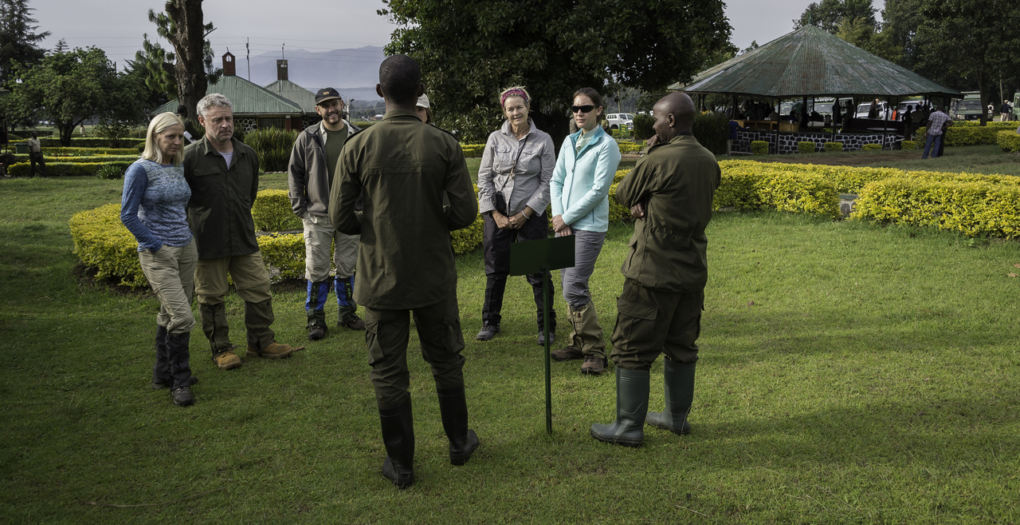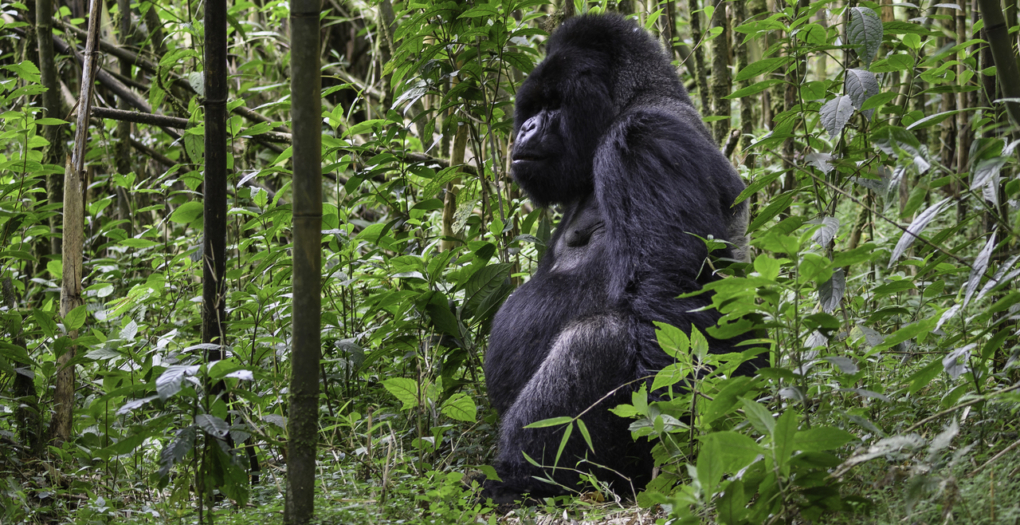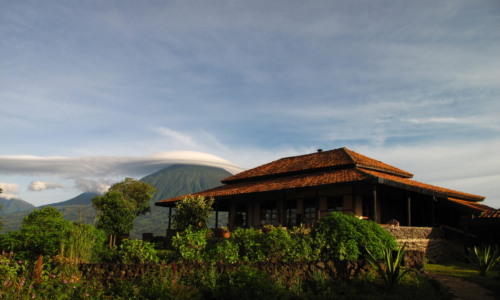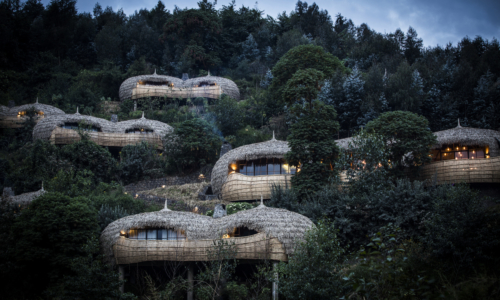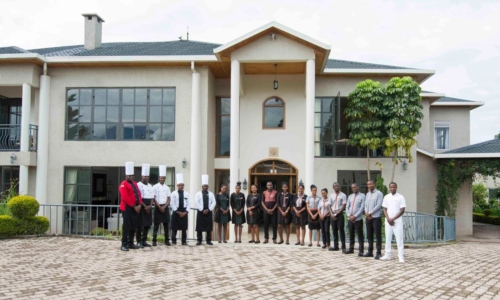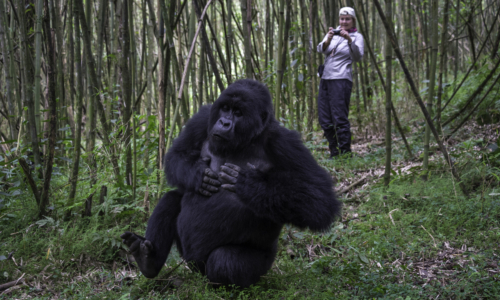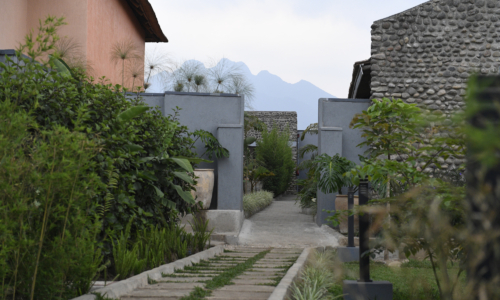Spanning ninety-nine miles in the northern part of Rwanda, Volcanoes National Park is the oldest national park in Africa. As a part of the great volcanic chain of the Virunga Mountains that straddles the borders of Rwanda, Uganda, and the DRC, it included the five extinct volcanoes: Muhabura, Sabyinyo, Gahinga, Karisimbi and Bisoke. The landscape is a mix of lush bamboo and Hygenia rainforest, open grassland and swamp. The park’s altitude ranges from about 8,202 feet to the peak of Karisimbi, at 14,763 feet resulting in extensive bamboo forests and some of the last remaining afro-montane forest habitat on the planet. Of course, the park’s most famous visitor, Dian Fossey, set up the Karisoke Research Center to carry out her gorilla research. She is widely credited with saving the gorillas from extinction by bringing their plight to the attention of the international community and is the inspiration for the book and film Gorillas in the Mist.
The park is best known for its mountain gorilla as roughly half the world’s population live here. The mountain gorillas are up to three times the size of the average man with males weighing around 430 pounds. Fully erect males may reach six feet three inches in height with an arm span of eight feet six inches long. Their thick fur enables them to live in colder climates. Adult males are called silverbacks because a saddle of gray or silver-colored hair develops on their backs with age.
Other primates and mammals living here include Ruwenzori Colobus, L’hoest monkey, silver monkey, golden monkey, owl faced monkey, red tailed monkey, dent’s monkey, crowned monkey, black faced vervet monkey, grey cheeked mangabey, olive baboons, galagos and pottosgolden monkey, as well as black-fronted duiker, buffalo, spotted hyena, and bushbuck. There have been reported sightings of elephant in the park, though these are now very rare. However, there are almost 200 recorded bird species in the Virunga and Ruwenzori Mountains.
Activities in the park center on gorilla visits; there are eight habituated groups that visitors can observe. There are also treks up to see Dian Fossey’s research center and grave. For an easier walk, there is always a golden monkey trek to watch these playful creatures jumping and climbing through the trees. Guided hikes of Mt. Bisoke take a full day to reach the summit with rewarding views of the rainforest and crater. Nature and bird walks take in the other wildlife in the area. Visitors can even hike downwards through the enormous openings of the Musanze Caves which were formed by centuries old eruptions.

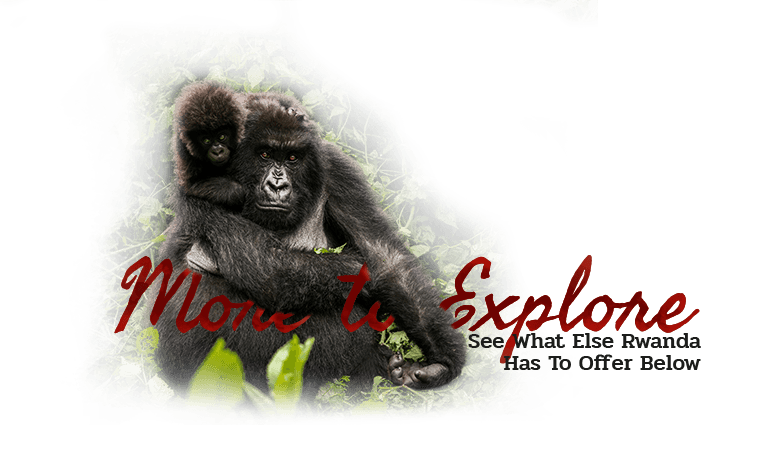
Coming soon!
Coming soon!

Spanning ninety-nine miles in the northern part of Rwanda, Volcanoes National Park is the oldest national park in Africa. As a part of the great volcanic chain of the Virunga Mountains that straddles the borders of Rwanda, Uganda, and the DRC, it included the five extinct volcanoes: Muhabura, Sabyinyo, Gahinga, Karisimbi and Bisoke. The landscape is a mix of lush bamboo and Hygenia rainforest, open grassland and swamp. The park’s altitude ranges from about 8,202 feet to the peak of Karisimbi, at 14,763 feet resulting in extensive bamboo forests and some of the last remaining afro-montane forest habitat on the planet. Of course, the park’s most famous visitor, Dian Fossey, set up the Karisoke Research Center to carry out her gorilla research. She is widely credited with saving the gorillas from extinction by bringing their plight to the attention of the international community and is the inspiration for the book and film Gorillas in the Mist.
The park is best known for its mountain gorilla as roughly half the world’s population live here. The mountain gorillas are up to three times the size of the average man with males weighing around 430 pounds. Fully erect males may reach six feet three inches in height with an arm span of eight feet six inches long. Their thick fur enables them to live in colder climates. Adult males are called silverbacks because a saddle of gray or silver-colored hair develops on their backs with age.
Other primates and mammals living here include Ruwenzori Colobus, L’hoest monkey, silver monkey, golden monkey, owl faced monkey, red tailed monkey, dent’s monkey, crowned monkey, black faced vervet monkey, grey cheeked mangabey, olive baboons, galagos and pottosgolden monkey, as well as black-fronted duiker, buffalo, spotted hyena, and bushbuck. There have been reported sightings of elephant in the park, though these are now very rare. However, there are almost 200 recorded bird species in the Virunga and Ruwenzori Mountains.
Activities in the park center on gorilla visits; there are eight habituated groups that visitors can observe. There are also treks up to see Dian Fossey’s research center and grave. For an easier walk, there is always a golden monkey trek to watch these playful creatures jumping and climbing through the trees. Guided hikes of Mt. Bisoke take a full day to reach the summit with rewarding views of the rainforest and crater. Nature and bird walks take in the other wildlife in the area. Visitors can even hike downwards through the enormous openings of the Musanze Caves which were formed by centuries old eruptions.

Coming soon!
Coming soon!






 Safari Camps
Safari Camps Points of Interest
Points of Interest Hotels & Resorts
Hotels & Resorts  Journeys
Journeys


